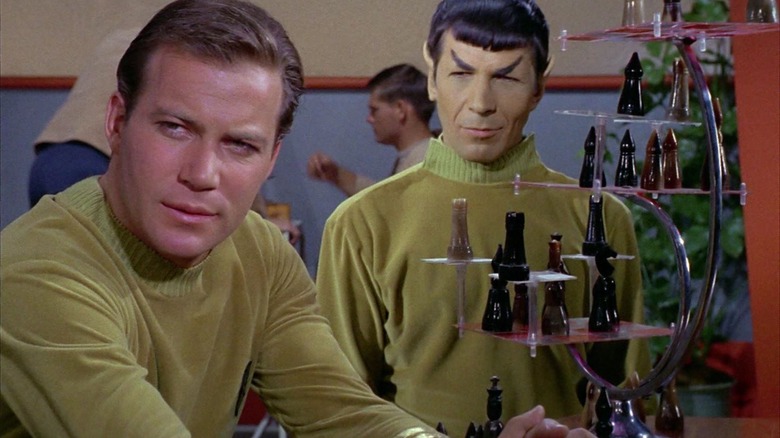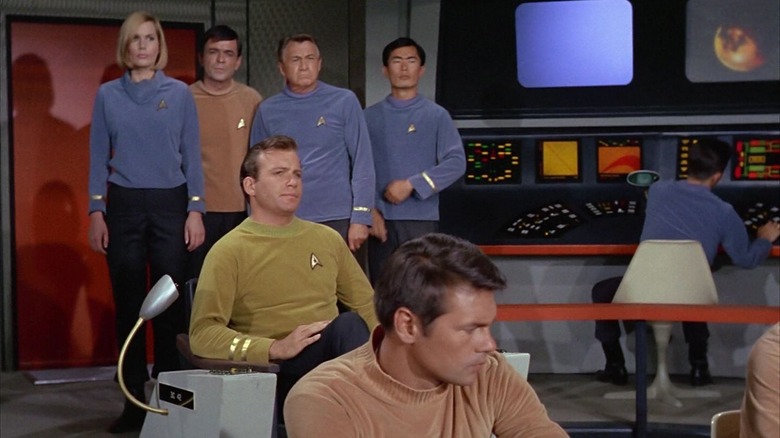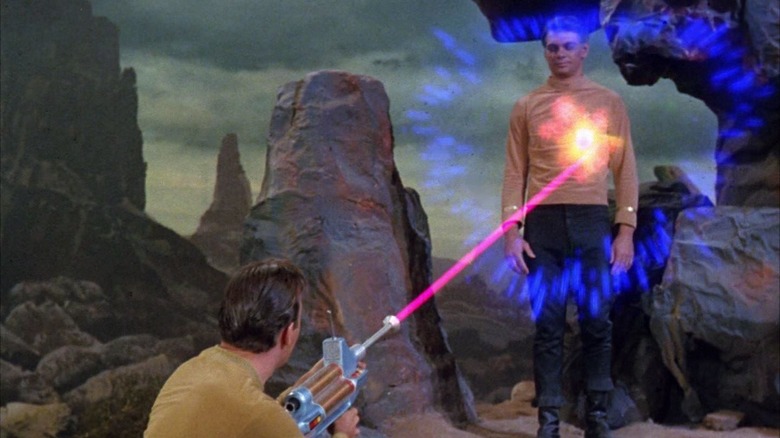An Unaired Version Of Star Trek's Second Pilot Was Saved By The Smithsonian
Back in 1965, NBC liked the concept of "Star Trek." Show creator Gene Roddenberry had presented a pilot called "The Cage," and the space adventure was beloved by the studio. It did, however, demand that the series undergo a major restructuring, forcing Roddenberry to write a second pilot with all-new characters, save the Vulcan Spock (Leonard Nimoy). The new pilot featured Captain James T. Kirk (William Shatner) and the "Star Trek" ensemble we have all come to know and love. The episode itself was called "Where No Man Has Gone Before" and aired on September 22, 1966, presented as the show's third episode.
"Where No Man" is still somewhat unpolished, of course. The uniforms don't quite match the red-blue-gold combo they would eventually become, for instance, and the story was larger and more psychedelic than the more character-driven 1967 heyday of the series. "Where No Man" is still pretty great, though, and centers on a mysterious cosmic power that turns humans into godlike beings.
Some Trekkies might be able to tell you that the aired version of "Where No Man" is actually a different cut than the original pilot Roddenberry wrote. The original cut only aired once, at a sci-fi convention in Cleveland, and it was five minutes longer than the on-air cut. It featured lengthier narration from Shatner and different music. The episode needed to be shortened to fit into the 50-minute timeslot mandated by NBC.
The original cut was haphazardly archived in 1966, sadly, and subsequently, wasn't seen for decades. Many considered it lost. It wasn't until 2009 that a print was discovered in Germany (!) and brought to Paramount's attention. That version was immediately restored and put on a "Star Trek" Blu-ray.
Notably, the longer cut was already being protected by the Smithsonian's Air and Space Museum.
The original cut of 'Where No Man Has Gone Before'
The reason "Where No Man Has Gone Before" served as the third episode of "Star Trek" was because NBC deemed it to be too talky. That was an issue the network had with "The Cage" as well. The first episode of "Star Trek" was, instead, "The Man Trap," an episode about a scary, shape-shifting salt vampire monster that kills people on the Enterprise. It wasn't a great introduction to the characters, but "The Man Trap" at least promised mayhem.
The shorter cut does not suffer from the edits, but the longer version does, as mentioned, have some more dramatic elbow room. Also, Trekkies love a good talky drama, so more dialogue and less action is no bad thing. The longer cut, when it was finally put on the season 3 Blu-ray of "Star Trek," was titled "Where No Fan Has Gone Before: The Restored, Unaired Alternate Pilot Episode." It didn't majorly alter the canon of "Star Trek," but purists could finally breathe a sigh of relief. The original pilot was, for the first time, commercially available, and Trekkies had a glorious time arguing which version counts as the "official" one.
The differences will be striking to Trekkies. Montgomery Scott, played by James Doohan, is credited only as "Engineer," while Lieutanant Sulu (George Takei) is, bafflingly, listed as "Physicist." Meanwhile, the ship's doctor was played by veteran actor Paul Fix, who was only credited as "Ship's Doctor." The episode also features a completely different theme song, which had previously been released on CD. Immutable parts of "Star Trek" lore hadn't yet been decided on.
The Smithsonian already had it
The Smithsonian, it should be noted, already had the longer version of "Where No Man Has Gone Before," as Roddenberry had been invited to donate various "Star Trek" ephemera to the institute ... merely because the Smithsonian guys were fans. The institute felt that "Star Trek" presented science and scientific thinking more powerfully than many of its contemporaries, and Roddenberry was phoned up at the conclusion of the show's first season to hand off a few prints. Roddenberry, happy to hype his series, obliged. Indeed, when "Star Trek" ran into ratings troubles at the end of its second season, Roddenberry was able to appeal to NBC, noting that pieces of the show were already inducted into the Smithsonian.
The Smithsonian wasn't able to commercially release or license an episode of "Star Trek," however, and one can only imagine the legal rigmarole a studio would have to go through to get the footage in question. As such, the pilot — while archived — wasn't available to the public. The original cut of "Where No Man" wasn't lost, but only a few key employees of the Smithsonian had access to it.
The Smithsonian has long been interested in "Star Trek," as the show's scientific bent inspired a great number of professional pilots, astronauts, and engineers. One of the first things a guest might see walking through the door of the Air and Space Museum in Washington, DC is a screen-used, fully-restored model of the Enterprise dating back to 1966. The museum also has the rubber Vulcan ear appliances worn by actor Leonard Nimoy, as well as one of the show's original Tribbles, a screen-used communication badge, a necklace seen in the episode "Catspaw" (October 27, 1967), and a uniform worn by actor Nichelle Nichols.


